Zoom
Trash

Cello. Cellos were derived from other mid- to large-sized bowed instruments in the 16th century, such as the viola da gamba, and the generally smaller and squarer viola da braccio, and such instruments made by members of the Amati family of luthiers.
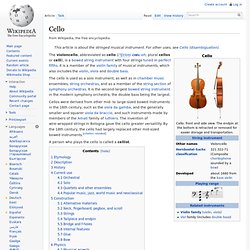
The invention of wire-wrapped strings in Bologna gave the cello greater versatility. By the 18th century, the cello had largely replaced other mid-sized bowed instruments. [citation needed] A person who plays the cello is called a cellist. Etymology[edit] Facts About Cello the Instrument. About The Harp. Harp The harp is one of the world's most ancient and universal instruments; two facts possibly associated with the simplicity of its earliest forms.
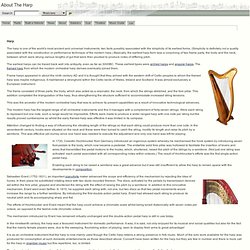
(Simplicity is definitely not a quality associated with the construction or performance technique of the modern harp.) Basically, the earliest harp-form was a conjoining of two frame parts; the body and the neck, between which were strung various lengths of gut that were then plucked to produce notes of differing pitch. The earliest harps can be traced back well into antiquity, even as far as 3000BC.
These earliest types were arched harps and angular harps. Homepage. The harp is one of the oldest instruments known to humankind, dating back to at least 3000 B.C.
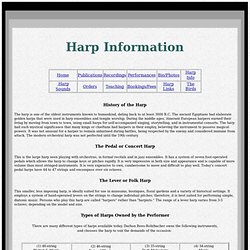
The ancient Egyptians had elaborate golden harps that were used in harp ensembles and temple worship. During the middle ages, itinerant European harpers earned their living by moving from town to town, using small harps for self-accompanied singing, storytelling, and in instrumental consorts. The harp had such mystical significance that many kings or chieftans had harpers in their employ, believing the instrument to possess magical powers. It was not unusual for a harper to remain unharmed during battles, being respected by the enemy and considered immune from attack. Harp Instrument Information. Piano. The pianoforte, commonly abbreviated to piano,[1] is a musical instrument played using a keyboard. Piano Facts for Kids. Piano Education for Kids at zZounds. Introduction Known as “The King of Instruments”, the piano is an exciting instrument to learn to play.

It was invented by a man named Bartolomeo Cristofori in Florence, Italy around the year 1698. He was a craftsman who repaired harpsichords, and the early piano he invented was an attempt to improve on that instrument. He wanted to make a version of the harpsichord that was able to be played both softly and loudly, and he called his early piano the piano-forte, which means “softly and loudly” in Italian. These early pianos were a little different from modern pianos, and they were so expensive that only royalty and the very rich could afford them. Famous Composers Don’t assume that famous piano composers are stuffy, old and boring. Wolfgang Amadeus Mozart: Mozart composed his first piano solo at age five, and could actually write music before he could write words! Tips on How to Have Fun with Lessons Piano lessons and piano practice don’t have to be boring! Cool Sites. Violin.
A young violinist The violin is sometimes informally called a fiddle, regardless of the type of music played on it.
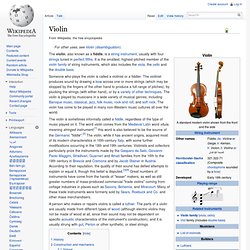
The word violin comes from the Medieval Latin word vitula, meaning stringed instrument;[1] this word is also believed to be the source of the Germanic "fiddle".[2] The violin, while it has ancient origins, acquired most of its modern characteristics in 16th-century Italy, with some further modifications occurring in the 18th and 19th centuries.
Violinists and collectors particularly prize the instruments made by the Gasparo da Salò, Giovanni Paolo Maggini, Stradivari, Guarneri and Amati families from the 16th to the 18th century in Brescia and Cremona and by Jacob Stainer in Austria. A person who makes or repairs violins is called a luthier. History[edit] Turkic and Mongolian horsemen from Inner Asia were probably the world’s earliest fiddlers. Violin Facts. Violin - The History of the Violin. Guitar. The History of Guitars for Kids. Information on Guitar History for Kids Many different ways exist to play music--blowing across an oboe's reeds, pounding on a drum, tickling the ivories of a piano--but one...
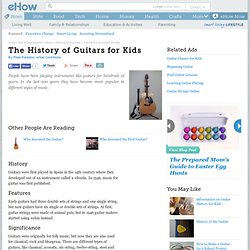
Guitar Facts You May Also Like. Information on Guitar History for Kids. Many different ways exist to play music--blowing across an oboe's reeds, pounding... Classical Guitar Information and History Information on Guitar History for Kids. Many different ways exist to play music--blowing across an oboe's reeds, pounding on a drum, ... Information on Guitar History for Kids. Viola. Music that is written for the viola differs from that of most other instruments, in that it primarily uses the alto clef, which is otherwise rarely used.
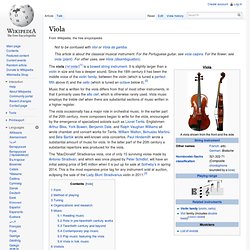
Viola music employs the treble clef when there are substantial sections of music written in a higher register. The viola occasionally has a major role in orchestral music. In the earlier part of the 20th century, more composers began to write for the viola, encouraged by the emergence of specialized soloists such as Lionel Tertis. Englishmen Arthur Bliss, York Bowen, Benjamin Dale, and Ralph Vaughan Williams all wrote chamber and concert works for Tertis. William Walton, Bohuslav Martinů and Béla Bartók wrote well-known viola concertos. The "MacDonald" Stradivarius viola, one of only 10 surviving violas made by Antonio Stradivari, and which was once played by Peter Schidlof, will have an initial asking price of $45 million when it is put up for sale at Sotheby's in spring 2014.
Form[edit] Method of playing[edit] Tuning[edit] Facts About the Instrument Viola. Entry - Facts from the Encyclopedia on Yahoo! Kids.